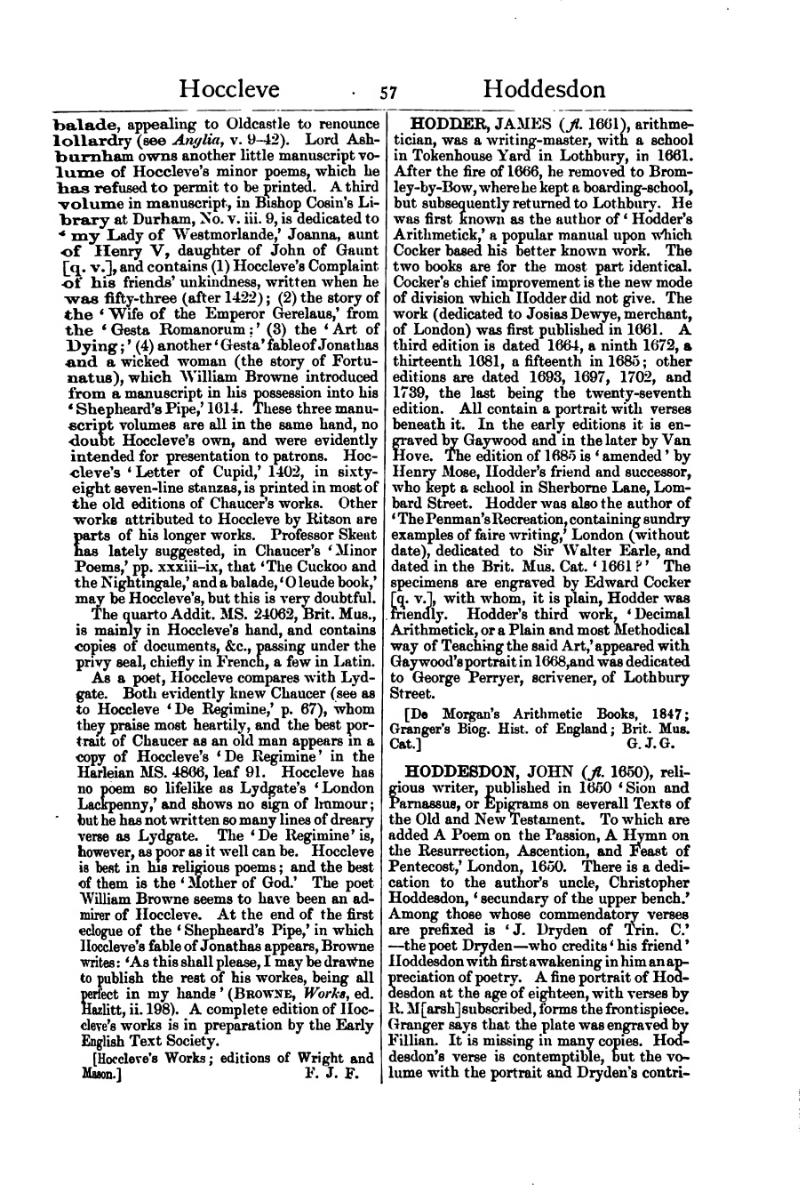balade, appealing to Oldcastle to renounce lollardry (see Anglia, v. 9–42). Lord Ashburnham owned another little manuscript volume of Hoccleve's minor poems. A third volume in manuscript, in Bishop Cosin's Library at Durham, No. v. iii. 9, is dedicated to ‘my Lady of Westmorlande,’ Joanna, aunt of Henry V, daughter of John of Gaunt [q. v.], and contains (1) Hoccleve's Complaint of his friends' unkindness, written when he was fifty-three (after 1422); (2) the story of the ‘Wife of the Emperor Gerelaus,’ from the ‘Gesta Romanorum;’ (3) the ‘Art of Dying;’ (4) another ‘Gesta’ fable of Jonathas and a wicked woman (the story of Fortunatus), which William Browne introduced from a manuscript in his possession into his ‘Shepheard's Pipe,’ 1614. These three manuscript volumes are all in the same hand, no doubt Hoccleve's own, and were evidently intended for presentation to patrons. Hoccleve's ‘Letter of Cupid,’ 1402, in sixty-eight seven-line stanzas, is printed in most of the old editions of Chaucer's works. Other works attributed to Hoccleve by Ritson are parts of his longer works. Professor Skeat has lately suggested, in Chaucer's ‘Minor Poems,’ pp. xxxiii–ix, that ‘The Cuckoo and the Nightingale,’ and a balade, ‘O leude book,’ may be Hoccleve's, but this is very doubtful.
The quarto Addit. MS. 24062, Brit. Mus., is mainly in Hoccleve's hand, and contains copies of documents, &c., passing under the privy seal, chiefly in French, a few in Latin.
As a poet, Hoccleve compares with Lydgate. Both evidently knew Chaucer (see as to Hoccleve ‘De Regimine,’ p. 67), whom they praise most heartily, and the best portrait of Chaucer as an old man appears in a copy of Hoccleve's ‘De Regimine’ in the Harleian MS. 4866, leaf 91. Hoccleve has no poem so lifelike as Lydgate's ‘London Lackpenny,’ and shows no sign of humour; but he has not written so much dreary verse as Lydgate. The ‘De Regimine’ is, however, very poor. Hoccleve is best in his religious poems; and the best of them is the ‘Mother of God.’ The poet William Browne seems to have been an admirer. At the end of the first eclogue of the ‘Shepheard's Pipe,’ in which Hoccleve's fable of Jonathas appears, Browne writes: ‘As this shall please, I may be drawne to publish the rest of his workes, being all perfect in my hands’ (Browne, Works, ed. Hazlitt, ii. 198). A complete edition of Hoccleve's works is in preparation by the Early English Text Society.
[Hoccleve's Works; editions of Wright and Mason.]
HODDER, JAMES (fl. 1661), arithmetician, was a writing-master, with a school in Tokenhouse Yard in Lothbury, in 1661. After the fire of 1666, he removed to Bromley-by-Bow, where he kept a boarding-school, but subsequently returned to Lothbury. He was first known as the author of ‘Hodder's Arithmetick,’ a popular manual upon which Cocker based his better known work. The two books are for the most part identical. Cocker's chief improvement is the new mode of division which Hodder did not give. The work (dedicated to Josias Dewye, merchant, of London) was first published in 1661. A third edition is dated 1664, a ninth 1672, a thirteenth 1681, a fifteenth in 1685; other editions are dated 1693, 1697, 1702, and 1739, the last being the twenty-seventh edition. All contain a portrait with verses beneath it. In the early editions it is engraved by Gaywood and in the later by Van Hove. The edition of 1685 is ‘amended’ by Henry Mose, Hodder's friend and successor, who kept a school in Sherborne Lane, Lombard Street. Hodder was also the author of ‘The Penman's Recreation, containing sundry examples of faire writing,’ London (without date), dedicated to Sir Walter Earle, and dated in the Brit. Mus. Cat. ‘1661?’ The specimens are engraved by Edward Cocker [q. v.], with whom, it is plain, Hodder was friendly. Hodder's third work, ‘Decimal Arithmetick, or a Plain and most Methodical way of Teaching the said Art,’ appeared with Gaywood's portrait in 1668, and was dedicated to George Perryer, scrivener, of Lothbury Street.
[De Morgan's Arithmetic Books, 1847; Granger's Biog. Hist. of England; Brit. Mus. Cat.]
HODDESDON, JOHN (fl. 1650), religious writer, published in 1650 ‘Sion and Parnassus, or Epigrams on severall Texts of the Old and New Testament. To which are added A Poem on the Passion, A Hymn on the Resurrection, Ascention, and Feast of Pentecost,’ London, 1650. There is a dedication to the author's uncle, Christopher Hoddesdon, ‘secundary of the upper bench.’ Among those whose commendatory verses are prefixed is ‘J. Dryden of Trin. C.’—the poet Dryden—who credits ‘his friend’ Hoddesdon with first awakening in him an appreciation of poetry. A fine portrait of Hoddesdon at the age of eighteen, with verses by R. M[arsh] subscribed, forms the frontispiece. Granger says that the plate was engraved by Fillian. It is missing in many copies. Hoddesdon's verse is contemptible, but the volume with the portrait and Dryden's contri-
